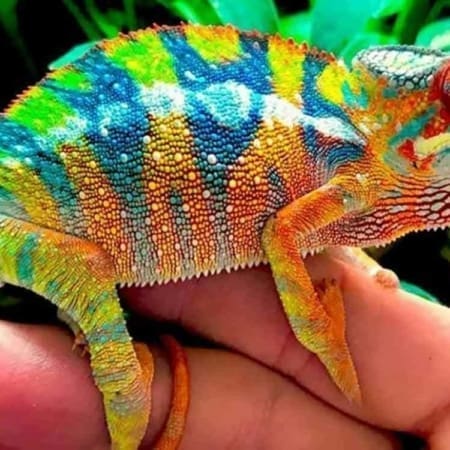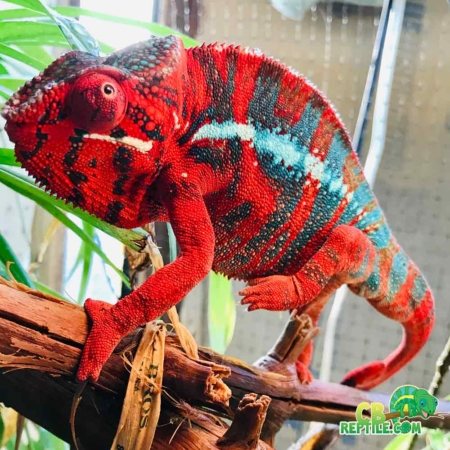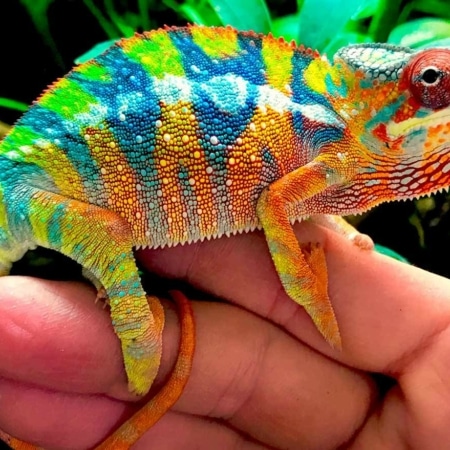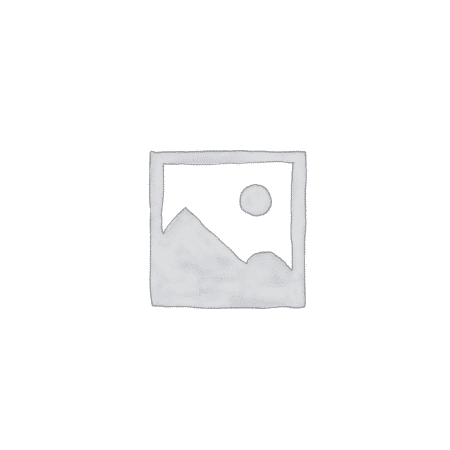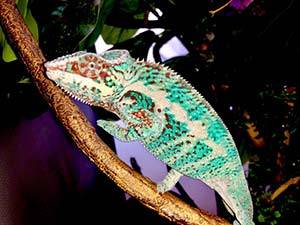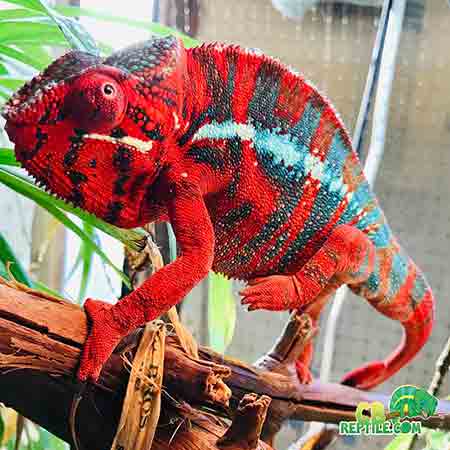Caring for Ambilobe Panther Chameleons in Captivity
Ambilobe panther chameleons require the same core husbandry as other panther locales, but there are a few practical tips that can help you bring out the very best in their intense colors and bold personalities. From enclosure design and diet to stress reduction and routine care, small details can make a big difference in how your Ambilobe looks and behaves.
This care-focused page assumes you already understand basic panther chameleon husbandry. Here, we concentrate on practical adjustments and Ambilobe-specific considerations that help your animal reach its full potential. Starting with a well-raised, captive-bred juvenile from the best panther chameleon breeder gives you the strongest foundation. The rest is about dialing in the environment in your home.

Enclosure Design for Ambilobe Display
Because Ambilobes are so visually impressive, most keepers want them front and center in a display enclosure. A vertical screen or hybrid cage measuring at least 24 x 24 x 48 inches provides room to climb and explore. Natural branches, sturdy vines, and a mix of real and artificial foliage create a three-dimensional environment that showcases color without sacrificing security.
Place the enclosure in a space with moderate foot traffic where the chameleon can see people but not be constantly disturbed. Avoid placing the cage directly next to loud speakers, drafty windows, or high-traffic doorways. The goal is a balance between visibility and calm.
Lighting to Bring Out Color
Correct lighting is essential for both health and visual impact. High-quality UVB, a properly set basking spot, and bright, full-spectrum visible lighting all influence how your Ambilobe appears. A well-hydrated, healthy chameleon under strong, naturalistic lighting will fire more vivid colors than one kept in a dim, poorly lit enclosure.
Many keepers pair a T5 high-output UVB fixture with an LED plant light for brightness and a halogen or incandescent basking bulb for warmth. When your Ambilobe warms up in the morning, you will often see its brightest displays of reds, yellows, and blues.
Diet & Feeding Strategies for Ambilobes
Ambilobe panther chameleons thrive on a varied, insect-based diet. Crickets, dubia roaches, black soldier fly larvae, silkworms, and other feeders all have a place in a healthy rotation. Gut loading and supplementation are key for long-term health.
- Offer smaller meals more frequently to juveniles.
- Feed adults every other day or in modest daily portions.
- Dust lightly with calcium at most feedings and use a multivitamin periodically.
Overfeeding fatty insects can lead to obesity, which dulls color and stresses organs. Focus on lean, well-gut-loaded feeders for the best results.
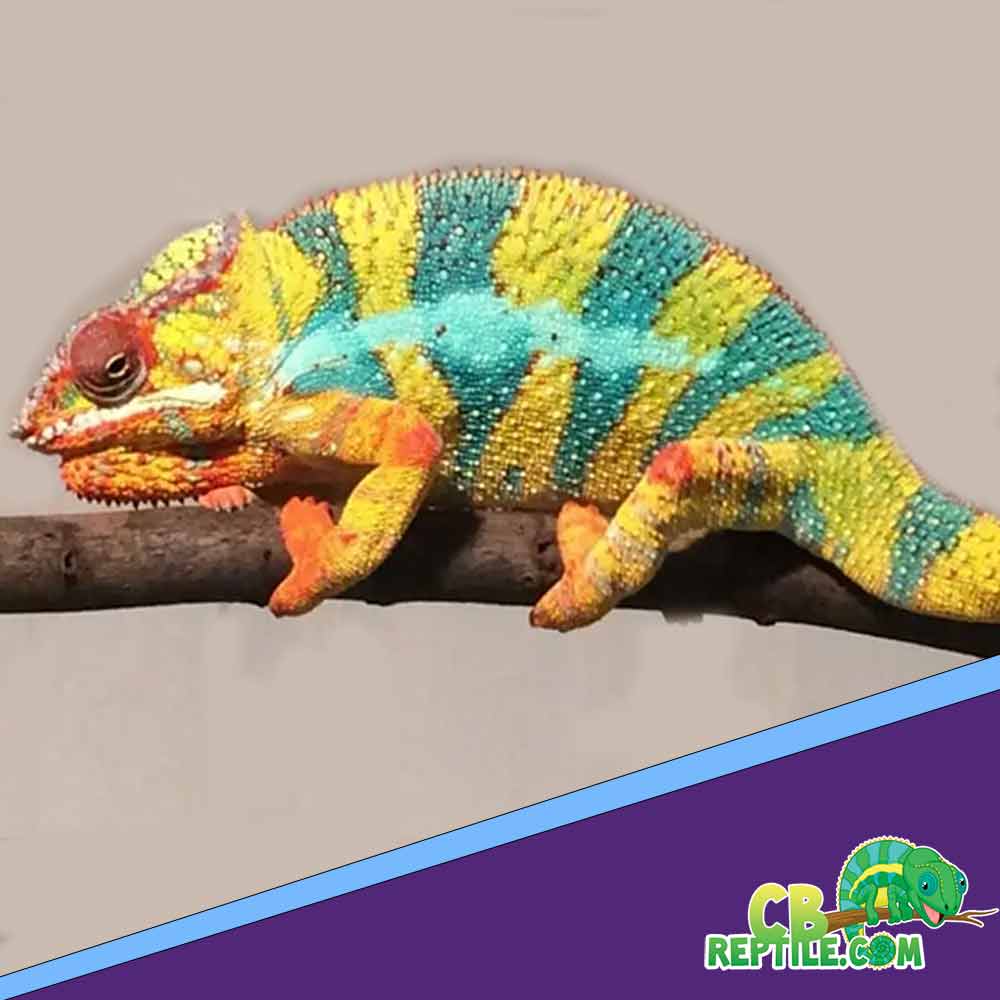
Hydration, Humidity & Shedding
Proper hydration is especially important for Ambilobes because their intense coloration is easier to appreciate when the skin is smooth, well-hydrated, and free from stuck shed. Automatic misting systems, nighttime fogging, and thoughtful plant placement all help create realistic humidity cycles.
Healthy Ambilobes shed cleanly, typically in patches over a few days. If you notice repeated stuck shed around the toes, casque, or tail tip, it may indicate hydration or environmental issues. Adjust misting length, fogging frequency, or enclosure ventilation until you consistently see crisp, complete sheds.
Managing Stress & Encouraging Natural Behavior
Ambilobe panther chameleons can be bold, but they are still chameleons. They dislike constant handling and rarely appreciate being restrained. Short, calm interactions are usually tolerated better than extended sessions. Many keepers find that hand-feeding occasional insects is a great way to build trust without unnecessary stress.
Signs of chronic stress include dark coloration, frequent hiding, gaping when approached, and refusal to eat when people are nearby. Adjusting the enclosure layout, raising the cage higher, adding more foliage, or relocating the habitat to a calmer part of the room can make a big difference.
Long-Term Health & Vet Care
Ambilobe panther chameleons can live five to seven years or longer with proper care. Regular observation, weight monitoring, and occasional veterinary checkups help catch issues early. A chameleon-savvy veterinarian can assist with fecal exams, supplementation questions, and any injuries or infections that may arise.
Good husbandry minimizes the need for emergency vet visits. Stable lighting, temperatures, hydration cycles, and nutrition form the foundation of long-term Ambilobe health. Animals produced by professional facilities generally start ahead of the curve because they were raised under optimal conditions from the beginning.
Choosing Your Ambilobe & Next Steps
If you are still in the planning phase and deciding where to buy chameleon that truly reflects the Ambilobe locale, look for a breeder that specializes in panther chameleons, offers clear parent photos, and provides detailed care support. Captive-bred juveniles from a focused Ambilobe program will adapt more quickly and show more predictable coloration than random, poorly documented imports.
Once your enclosure is ready, your lighting is dialed in, and your hydration system is tested, you are prepared to welcome an Ambilobe panther chameleon into your home. With consistent care and attention to detail, you will be rewarded with one of the most spectacular display reptiles in the hobby, showcasing the full beauty of the Ambilobe locale for years to come.

